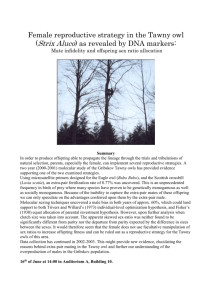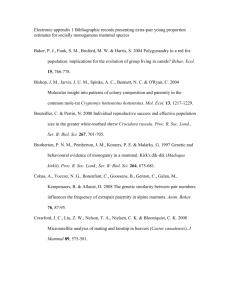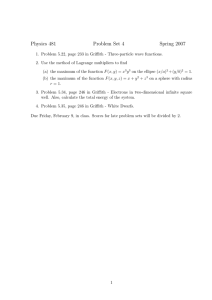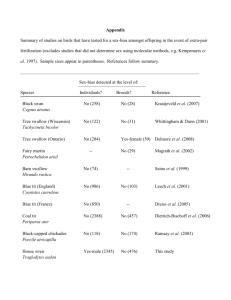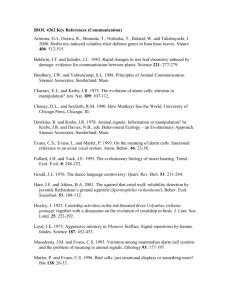Why do birds engage in
advertisement
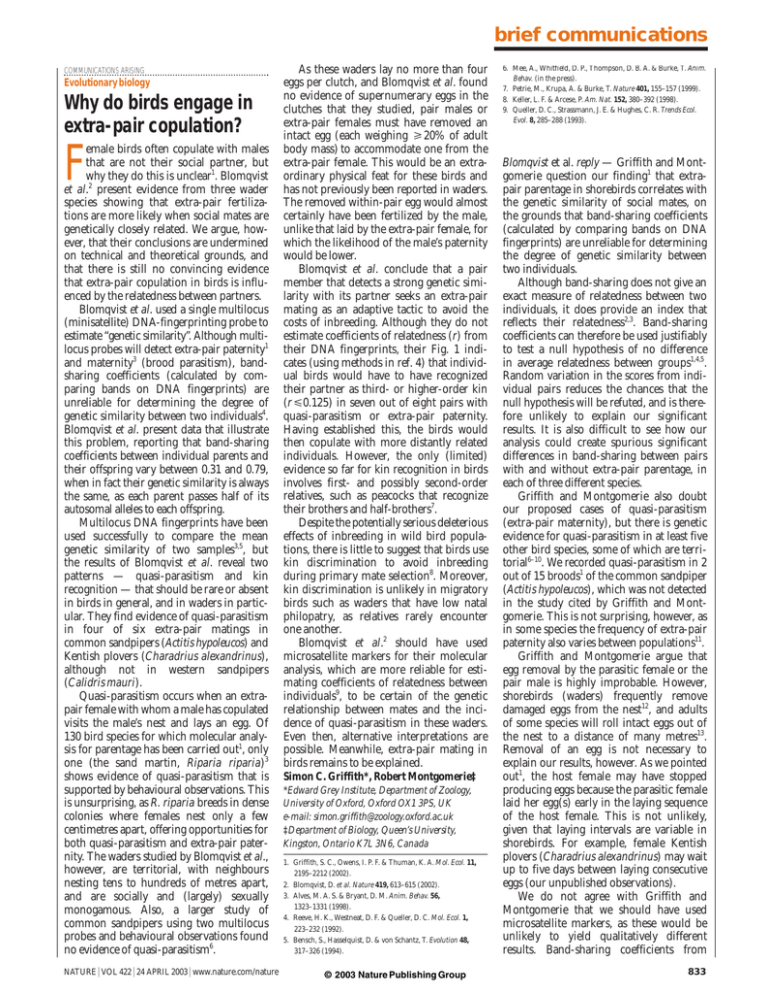
brief communications COMMUNICATIONS ARISING Evolutionary biology Why do birds engage in extra-pair copulation? emale birds often copulate with males that are not their social partner, but why they do this is unclear1. Blomqvist et al.2 present evidence from three wader species showing that extra-pair fertilizations are more likely when social mates are genetically closely related. We argue, however, that their conclusions are undermined on technical and theoretical grounds, and that there is still no convincing evidence that extra-pair copulation in birds is influenced by the relatedness between partners. Blomqvist et al. used a single multilocus (minisatellite) DNA-fingerprinting probe to estimate “genetic similarity”. Although multilocus probes will detect extra-pair paternity1 and maternity3 (brood parasitism), bandsharing coefficients (calculated by comparing bands on DNA fingerprints) are unreliable for determining the degree of genetic similarity between two individuals4. Blomqvist et al. present data that illustrate this problem, reporting that band-sharing coefficients between individual parents and their offspring vary between 0.31 and 0.79, when in fact their genetic similarity is always the same, as each parent passes half of its autosomal alleles to each offspring. Multilocus DNA fingerprints have been used successfully to compare the mean genetic similarity of two samples3,5, but the results of Blomqvist et al. reveal two patterns — quasi-parasitism and kin recognition — that should be rare or absent in birds in general, and in waders in particular. They find evidence of quasi-parasitism in four of six extra-pair matings in common sandpipers (Actitis hypoleucos) and Kentish plovers (Charadrius alexandrinus), although not in western sandpipers (Calidris mauri). Quasi-parasitism occurs when an extrapair female with whom a male has copulated visits the male’s nest and lays an egg. Of 130 bird species for which molecular analysis for parentage has been carried out1, only one (the sand martin, Riparia riparia)3 shows evidence of quasi-parasitism that is supported by behavioural observations. This is unsurprising, as R. riparia breeds in dense colonies where females nest only a few centimetres apart, offering opportunities for both quasi-parasitism and extra-pair paternity. The waders studied by Blomqvist et al., however, are territorial, with neighbours nesting tens to hundreds of metres apart, and are socially and (largely) sexually monogamous. Also, a larger study of common sandpipers using two multilocus probes and behavioural observations found no evidence of quasi-parasitism6. F NATURE | VOL 422 | 24 APRIL 2003 | www.nature.com/nature As these waders lay no more than four eggs per clutch, and Blomqvist et al. found no evidence of supernumerary eggs in the clutches that they studied, pair males or extra-pair females must have removed an intact egg (each weighing à20% of adult body mass) to accommodate one from the extra-pair female. This would be an extraordinary physical feat for these birds and has not previously been reported in waders. The removed within-pair egg would almost certainly have been fertilized by the male, unlike that laid by the extra-pair female, for which the likelihood of the male’s paternity would be lower. Blomqvist et al. conclude that a pair member that detects a strong genetic similarity with its partner seeks an extra-pair mating as an adaptive tactic to avoid the costs of inbreeding. Although they do not estimate coefficients of relatedness (r) from their DNA fingerprints, their Fig. 1 indicates (using methods in ref. 4) that individual birds would have to have recognized their partner as third- or higher-order kin (r 0.125) in seven out of eight pairs with quasi-parasitism or extra-pair paternity. Having established this, the birds would then copulate with more distantly related individuals. However, the only (limited) evidence so far for kin recognition in birds involves first- and possibly second-order relatives, such as peacocks that recognize their brothers and half-brothers7. Despite the potentially serious deleterious effects of inbreeding in wild bird populations, there is little to suggest that birds use kin discrimination to avoid inbreeding during primary mate selection8. Moreover, kin discrimination is unlikely in migratory birds such as waders that have low natal philopatry, as relatives rarely encounter one another. Blomqvist et al.2 should have used microsatellite markers for their molecular analysis, which are more reliable for estimating coefficients of relatedness between individuals9, to be certain of the genetic relationship between mates and the incidence of quasi-parasitism in these waders. Even then, alternative interpretations are possible. Meanwhile, extra-pair mating in birds remains to be explained. Simon C. Griffith*, Robert Montgomerie‡ *Edward Grey Institute, Department of Zoology, University of Oxford, Oxford OX1 3PS, UK e-mail: simon.griffith@zoology.oxford.ac.uk ‡Department of Biology, Queen’s University, Kingston, Ontario K7L 3N6, Canada 1. Griffith, S. C., Owens, I. P. F. & Thuman, K. A. Mol. Ecol. 11, 2195–2212 (2002). 2. Blomqvist, D. et al. Nature 419, 613–615 (2002). 3. Alves, M. A. S. & Bryant, D. M. Anim. Behav. 56, 1323–1331 (1998). 4. Reeve, H. K., Westneat, D. F. & Queller, D. C. Mol. Ecol. 1, 223–232 (1992). 5. Bensch, S., Hasselquist, D. & von Schantz, T. Evolution 48, 317–326 (1994). © 2003 Nature Publishing Group 6. Mee, A., Whitfield, D. P., Thompson, D. B. A. & Burke, T. Anim. Behav. (in the press). 7. Petrie, M., Krupa, A. & Burke, T. Nature 401, 155–157 (1999). 8. Keller, L. F. & Arcese, P. Am. Nat. 152, 380–392 (1998). 9. Queller, D. C., Strassmann, J. E. & Hughes, C. R. Trends Ecol. Evol. 8, 285–288 (1993). Blomqvist et al. reply — Griffith and Montgomerie question our finding1 that extrapair parentage in shorebirds correlates with the genetic similarity of social mates, on the grounds that band-sharing coefficients (calculated by comparing bands on DNA fingerprints) are unreliable for determining the degree of genetic similarity between two individuals. Although band-sharing does not give an exact measure of relatedness between two individuals, it does provide an index that reflects their relatedness2,3. Band-sharing coefficients can therefore be used justifiably to test a null hypothesis of no difference in average relatedness between groups1,4,5. Random variation in the scores from individual pairs reduces the chances that the null hypothesis will be refuted, and is therefore unlikely to explain our significant results. It is also difficult to see how our analysis could create spurious significant differences in band-sharing between pairs with and without extra-pair parentage, in each of three different species. Griffith and Montgomerie also doubt our proposed cases of quasi-parasitism (extra-pair maternity), but there is genetic evidence for quasi-parasitism in at least five other bird species, some of which are territorial6–10. We recorded quasi-parasitism in 2 out of 15 broods1 of the common sandpiper (Actitis hypoleucos), which was not detected in the study cited by Griffith and Montgomerie. This is not surprising, however, as in some species the frequency of extra-pair paternity also varies between populations11. Griffith and Montgomerie argue that egg removal by the parasitic female or the pair male is highly improbable. However, shorebirds (waders) frequently remove damaged eggs from the nest12, and adults of some species will roll intact eggs out of the nest to a distance of many metres13. Removal of an egg is not necessary to explain our results, however. As we pointed out1, the host female may have stopped producing eggs because the parasitic female laid her egg(s) early in the laying sequence of the host female. This is not unlikely, given that laying intervals are variable in shorebirds. For example, female Kentish plovers (Charadrius alexandrinus) may wait up to five days between laying consecutive eggs (our unpublished observations). We do not agree with Griffith and Montgomerie that we should have used microsatellite markers, as these would be unlikely to yield qualitatively different results. Band-sharing coefficients from 833 brief communications multilocus DNA fingerprinting, based on a single probe, have been shown to reflect genetic relatedness accurately in the redwinged blackbird (Agelaius phoeniceus)3. We maintain that our application of this method in testing for differences in the average level of relatedness between groups is justified. We agree with Griffith and Montgomerie that alternative explanations may need to be considered before concluding that mate choice is based on genetic diversity and kin discrimination. But, as we saw a similar pattern in three species with different ecology and social behaviour1, we contend that our proposal of adaptive extra-pair copulation with genetically dissimilar mates warrants further testing in these and other species. Donald Blomqvist, Malte Andersson, Clemens Küpper, Innes C. Cuthill, János Kis, Richard B. Lanctot, Brett K. Sandercock, Tamás Székely, Johan Wallander, Bart Kempenaers* *Max Planck Research Centre for Ornithology, PO Box 1564, 82305 Starnberg (Seewiesen), Germany e-mail: b.kempenaers@erl.ornithol.mpg.de 1. Blomqvist, D. et al. Nature 419, 613–615 (2002). 2. Lynch, M. DNA Fingerprinting: Approaches and Applications (eds Burke, T. et al.) 113–126 (Birkhäuser, Basel, 1991). 3. Reeve, H. K., Westneat, D. F. & Queller, D. C. Mol. Ecol. 1, 223–232 (1992). 4. Brown, K. M. Anim. Behav. 56, 1529–1543 (1998). 5. Petrie, M., Krupa, A. & Burke, T. Nature 401, 155–157 (1999). 6. Alves, M. A. S. & Bryant, D. M. Anim. Behav. 56, 1323–1331 (1998). 7. Hoi, H. & Hoi-Leitner, M. Behav. Ecol. 8, 113–119 (1997). 8. Reyer, H. U., Bollmann, K., Schläpfer, A. R., Schymainda, A. & Klecack, G. Behav. Ecol. 8, 534–543 (1997). 9. Schleicher, B., Hoi, H., Valera, F. & Hoi-Leitner, M. Behaviour 134, 941–959 (1997). 10. Václav, R., Hoi, H. & Blomqvist, D. Behav. Ecol. (in the press). 11. Petrie, M. & Kempenaers, B. Trends Ecol. Evol. 13, 52–58 (1998). 12. Sandercock, B. K. Oecologia 110, 50–59 (1997). 13. Chylarecki, P. Wader Study Group Bull. 94, 21–22 (2001). COMMUNICATIONS ARISING Astrophysics How did the metals in a giant star originate? he chemical composition of stars with extremely low metal contents (taking ‘metals’ to mean all elements other than hydrogen and helium) provides us with information on the masses of the stars that produced the first metals. Such a direct connection is not possible, however, if the surface of the star has been polluted by enriched material, either dredged from the star’s interior or transferred from a companion star. Here we argue that, in the case of HE0107–5240 (ref. 1), the most ironpoor star known, the oxygen abundance could be a discriminant: a ratio of [O/Fe] exceeding &3.5 would favour a pristine origin of metals, whereas an [O/Fe] ratio of less than &3 would favour the pollution T 834 hypothesis. Using this criterion, we suggest how the required information on oxygen abundance might be obtained. HE0107-5240 shows carbon, nitrogen and sodium enhanced, respectively, by factors of 104, 102.3 and 10 relative to iron, whereas magnesium, which is usually more abundant in metal-poor stars, is present in almost the same amounts as iron; no single supernova (SNII) model seems to show this pattern2. Although several models may be worth considering, we evaluate two here: a pristine origin due to the combined enrichment of at least two SNIIs, or a pollution of the surface of the star after its formation. If the metals are pristine, then HE0107–5240 must have formed from a cloud enriched by the ejecta of at least two zero-metallicity SNIIs of quite different initial masses. The first supernova, which was presumably rather massive, would have produced the light elements observed in HE0107–5240, but none of the heavier ones, because of an extensive fallback, up to the base of the helium shell. This would have prevented the ratios [C/N] and [Mg/C] from becoming too high. The second supernova, which was less massive, would have provided all of the elements heavier than and including magnesium. In contrast, in the case of pollution enrichment, HE0107–5240 would be either a low-mass, zero-metallicity star that accreted matter enriched by the first generation of SNII, or a second-generation lowmass star of very low metallicity. The high [C,N,Na/Fe] ratios would be the result of subsequent enrichment of the surface of the star, due either to an internal process or to the accretion of matter synthesized by an asymptotic giant branch (AGB) star in a binary system. One way to discriminate between pristine and pollution origins of C and N is to measure the abundance of oxygen. In the pristine case, the more massive supernova would provide a large amount of oxygen, leading to a high [O/Fe] (¤&3.5), as can be derived from the yields of zero-metal massive stars2. In the pollution case, a lower [O/Fe] is expected (*&3.0), as implied by the yields of zero-metal, intermediatemass stars3. An upper limit of 0.1 pm (where 1 pm is 10112 m) on the equivalent width of the [OI] 630-nm line would provide a limit on oxygen, namely [O/H]*12.3 or [O/Fe]*&3. With the Ultraviolet–Visual Echelle Spectrograph on the European Southern Observatory’s Very Large Telescope, we estimate that such a limit could be achieved in about 30 h of exposure. The situation is slightly better for OH ultraviolet lines, for which we estimate that an upper limit of [O/Fe]*&2.0 could be derived even at moderate signal-to-noise ratios (¤20), which should be achieved in about © 2003 Nature Publishing Group 4 h of exposure. At this signal-to-noise ratio, it is possible to discriminate between [O/Fe]*&3.0 and [O/Fe]¤&3.5; however, lower oxygen abundances would be very difficult to measure, whatever the signalto-noise ratio. As high-resolution spectra have already been obtained, including the ultraviolet region containing the OH lines, for a total of about 30 h of exposure (ESO/ST-ECF Science Archive), it may now be possible to carry out the test that we propose. Among extremely metal-poor stars, oxygen has been observed only in the star CS 22949–037 (ref. 4), for which [O/Fe]4&2.0; all other known stars have oxygen features that are below the detection threshold. However, CS 29498–043 (ref. 5) has a very similar pattern of marked overabundance of the lighter elements; its oxygen abundance, which has not yet been measured, may prove to be strongly enhanced as well. We note that the high observed [C/N] in HE0107-5240 is difficult to explain in terms of pollution, whether internal or from an AGB companion, because of the high abundance of primary nitrogen in both cases. We argue that a pristine origin is more likely, which implies that the [O/Fe] ratio is higher than in any other known metal-poor star. Piercarlo Bonifacio*, Marco Limongi†, Alessandro Chieffi‡ *Istituto Nazionale di Astrofisica, Osservatorio Astronomico di Trieste, 34131 Trieste, Italy e-mail: bonifaci@ts.astro.it †Istituto Nazionale di Astrofisica, Osservatorio Astronomico di Roma, 00040 Monteporzio Catone, Roma, Italy ‡Istituto di Astrofisica Spaziale, CNR, 00133 Roma, Italy 1. Christlieb, N. et al. Nature 419, 904–906 (2002). 2. Chieffi, A. & Limongi, M. Astrophys. J. 577, 281–294 (2002). 3. Chieffi, A., Limongi, M., Domìnguez, I. & Straniero, O. in New Quests in Stellar Astrophysics: The Link Between Stars and Cosmology (eds Chavez, M. et al.) 47–54 (Kluwer Academic, Dordrecht, The Netherlands, 2002). 4. Depagne, E. et. al. Astron. Astrophys. 390, 187–198 (2002). 5. Aoki, W., Norris, J. E., Ryan, S. G., Beers, T. C. & Ando, H. Astrophys. J. 576, L141–L144 (2002). addendum Adult persistence of head-turning asymmetry O. Güntürkün Nature 421, 711 (2003) Some confusion over the definition of the term ‘right kiss’ as used in this communication has resulted from the depiction of Auguste Rodin’s statue The Kiss, in which the male turns his head in the vertical plane to the left. However, this sculpture only served to illustrate the definition of a right kiss, which corresponds to a position in which the nose of each participant is to the right of the nose of the other. The strict criteria applied during my observations excluded couples in the position of Rodin’s statue and ensured that a right kiss incorporated a turn and a tilt with the head to the right side. NATURE | VOL 422 | 24 APRIL 2003 | www.nature.com/nature
